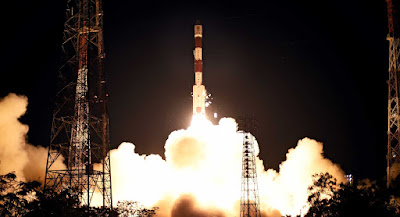Isro, on Monday, effectively propelled first astronomy satellite of India, Astrosat - after 11 years the legislature cleared the task.
At 10am, Astrosat, conveyed by a Polar Satellite Launch Vehicle (PSLV-C30) and six different satellites detonated from the Satish Dhawan Space Center in Sriharikota.
After liftoff, in around 25 minutes, PSLV-C30 infused Astrosat and different satellites, which include four nanosatellites of the US, an Indonesian microsatellite and a Canadian nanosatellite - into their separate courses. For the first time India is propelling a US satellite.
644.651km from earth Astrosat was put on a course, as wanted. The satellite accomplished a normal slant of 6.002 degrees.
P Kunhikrishnan, the director of Satish Dhawan Space Center, said after the dispatch, that the mission is fruitful. It is an all around perceived and synchronous endeavor. For him it was a well deserved blessing.
About Astrosat:
Astrosat, having a takeoff accumulation of 1,513kg, now will set out on a five-year cosmic operation concentrating on inaccessible divine articles.
It will monitor the universe in the bright, ocular, high and low energy x-beam areas of the electromagnetic range, contrasted with nearly all other exploratory satellites that are fit for watching a wavelength band’s restricted scope.
In the middle of its assignments, Astrosat’s 5 payloads will learn black-holes and star conception locales.
The website of ISRO records out the observatory’s target - to see high vitality forms in twofold star frameworks containing black-holes and neutron stars; to gauge magnetic grounds of neutron stars; to read star conception areas and lofty energy forms in star frameworks lying past the galaxy; to identify new sources for temporarily brilliant x-beam in the sky and finally to execute constrained profound ground-overview of the ultraviolet locale of the universe.
Astrosat, conveying 5 payloads, is equipped for watching the sky in the perceptible, close UV and far UV areas of the electromagnetic range.
There are two telescopes on the Ultraviolet Imaging Telescope (UVIT) payload, which are intended to accomplish a magnificent picture determination, whereas the other 4 payloads have their particular parts.
Alternate payloads are – Soft x-beam Telescope (SXT), Large X-Ray Proportional Counter (LAXPC), Charge Particle Monitor (CPM) and Cadmium Zinc Telluride Imager (CZTI).
On next Monday, the payloads will begin taking a shot, on the eighth day after dispatch.
There are two telescopes on the Ultraviolet Imaging Telescope (UVIT) payload, which are intended to accomplish a magnificent picture determination, whereas the other 4 payloads have their particular parts.
Alternate payloads are – Soft x-beam Telescope (SXT), Large X-Ray Proportional Counter (LAXPC), Charge Particle Monitor (CPM) and Cadmium Zinc Telluride Imager (CZTI).
On next Monday, the payloads will begin taking a shot, on the eighth day after dispatch.
